Francesca and Henk-Jan's Backpacking Trip!
Tuesday, May 18, 2010
Out In Manila
We planned for the 17th to be an ‘Exploring Manila’ day, seeing some of the sights around town. And we did just that! Well, kinda. First we walked to Robinson’s Mall and saw the ‘Cultural Festival’ display of colorful Philippines-made fans from various islands wasn’t on display yet. Thus we decided to grab a cab to the ‘SE Mall of Asia.’ This mall is the largest in all of South-East Asia (supposedly) and even has an ice-rink inside. While it wasn’t as interesting as our local Robinson’s, we enjoyed the huge selection they had of stuff to buy. Henk wanted to see the new ‘Robin Hood’ movie, so after lunch at Abe’s/Café Adriatico #2 where Henk got a bamboo rice dish we headed into the theater. After the movie we went to buy a Cinnabun for me, oblivious to the fact that I had forgotten my purse inside the theater. After a short while of running around the mall with theater staff, we picked up my purse from security and got a cab back to Robinson’s.
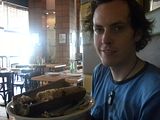
We then sat at Robinson’s enjoying a sample of purple ice-cream called “Ube,” a sweet and popular Filipino ice-cream that is made from yams. It took a while for the fan display to be set-up, so we walked around the mall. Henk and I ended up going back to the hostel, and he later went back to the mall to get his hair cut and take some pictures of the display for me. (This ended up being unnecessary since it was still up the next day!) The display was of Filipino paypay, which are hand-held fans used to keep cool. The display: “Crafted from various palm leaves, abaca, grasses including bamboo and vetiver (moras), even vines… the introduction of dyes… [made the fans] eye-catching… [and helped] signify their origin. ” Not just the color, but the shape of the fan marked the fan’s origin as well. Round fans were from Baler, flag-like fans from Vigan, ‘braided’ circle fans came from Bicol. The most popular fan is the heart-shaped, however. Take a look! (Also below is the Wiki picture of cake made from Ube. PURPLE!)

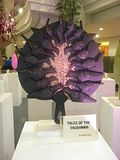
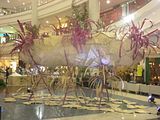
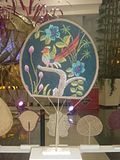
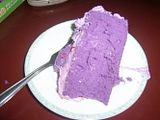
That night we ate at a cultural ‘dinner-and-a-show’ restaurant near the hostel called Zamboanga. While we dined on grilled chicken, French fries, fruit salad, and later a chocolate lava cake, we watched the show which ranged from ‘native’ pre-colonial dances, dances popularized in the Philippines by the Spanish, and a Japanese man being totally embarrassed by being forced on-stage in a grass skirt in front of his colleagues. Here are a few pictures of the various dances we saw:
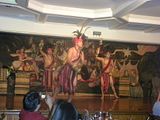
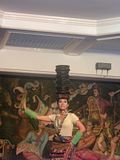
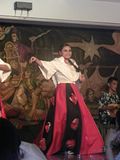
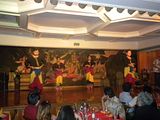
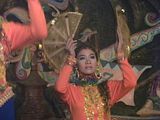
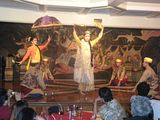
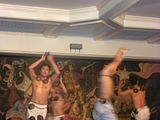
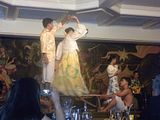
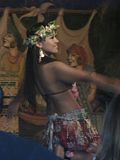
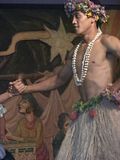
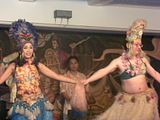
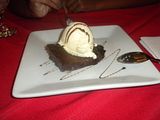
The next day Henk and I set out early to actually get some touristy-things done. We planned originally to head to the bigger museums in Manila, such as the National Museum of the Filipino People. Alas, it was closed, along with the sister museum next to it. I checked the website! But even the hours listed at the museum gate were different, so I guess you just have to wing it in these places. We instead made our way to Rizal Park. After snapping a picture of the Rizal statue, we passed by his execution site (also closed) to another statue, this one a Revolutionary memorial. There was even a giant statue of Lapu-Lapu, a chieftain from Mactan in Cebu who, with 1000 followers, defeated Magellan’s forces and killed the man himself in 1521, delaying the Spanish’s colonization of the Philippines by some years. At the end of the park was a large map of the Philippines… but we weren’t so impressed.
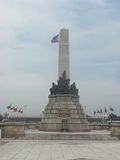
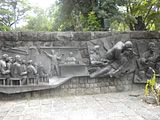
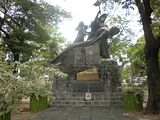
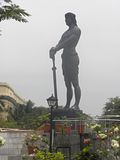
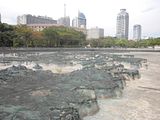
Next we headed back to Intramuros for a walk through Casa Manila in the Plaza San Luis. Casa Manila is a replica house used as a “colonial lifestyle museum.” The brochure explains that, “its façade was copied from a house (1850s) at Calle Jaboneros in San Nicolas, a district across the river. In that area, the first floor of houses were rented out to shopkeepers… the uppermost floors [also] extend outwards, helping to shade pedestrians during the day [but] also aided in stabilizing the living quarters. Its construction (upper floor made of wood, lower floor of adobe volcanic stones) was an example of a safe earthquake-proof construction knowledge gained by Spanish families living in the area. We stood outside on the little granite-paved area called the “zaguan” or the corridor. This is where the carriages entered, dropping off their passengers before proceeding to park the horses. It was connected to the patio area with fountain, where we stood with Carlos the day before. The granite stones used in houses such as this originally came from Chinese junk ships but later were sold for patios in the 1800’s. We bought our tickets and entered the house. Sadly we weren’t allowed to take any pictures, so I’ll have to use the aid of our brochure and the included stock photos on their website to help you all visualize what we saw.
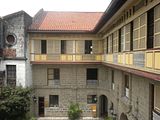
First we entered the “entresuelo” or the floor “between floors.” The brochure says, “…this area is where clients, tenants, or estate managers (if the owner was a rich landowner) wait before being admitted to the oficina (office).” We immediately noticed the beautiful detail in the wooden carvings on the ceiling and corners of the house. Very impressive. The furniture was carved wood and Mother of Pearl and everything looked expensive.
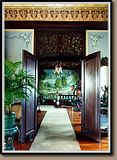
The “despacho” or “oficina” was, “where the owner of the house conducted business together with his clerks or accountants… the lubi-lubi plant (indigenious) [is] carved on the legs of the partners’ desk.” We continued walking through the house marveling as we went on just how large it was. It seemed to keep going and going! We later found out that this is because some extended family members (aunt, uncle, grandparents) lived with the nuclear family in the household.
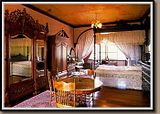

One of the most impressive rooms was the large ‘antesala/caida’ which was for general hanging-out by family members or close friends. The more formal living room, the ‘sala’ was a even larger room which could be cleared out for balls and performances. The house even had a mini chapel room called the ‘oratorio’ with statues/dolls of saints and other religious images of worship called ‘santos.’ The master bedroom, which was offered to important guests who need to stay overnight, and held many pieces of furniture indicating the family’s wealth.
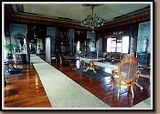
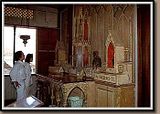
In the dining room we saw a working ‘punkah,’ which (according to the fan display from the mall) was: “a large, broad rectangular “fan” suspended from the ceiling. Hand-powered, one pulled on a rope to swing it to and fro. One of the guards demonstrated for us by pulling said rope. The kitchen was open to the dining room, so it must have gotten pretty hot in there. We looked around the kitchen which had fake food on display and examples of pantry-like storage. It even had a stovetop made of ash and water.
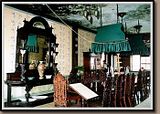
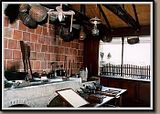
Beyond the kitchen was the toilet and washroom. The washroom was smartly placed near the kitchen, I’m guessing so hot baths would be easier. But the toilet was the real interesting area. There were two toilets side-by-side in the little room and there, according to the description on the wall, would be a checkerboard or other game board in between them. You could sit on the john with a friend and pass the time by challenging her/him to a game!
We then headed back to San Agustin’s Church for a second time. This time around we went upstairs, having a bit more time to wander around and get a few more photos. Next we went back outside, passing a memorial for those lost in the bombings of WWII. Henk and I had wanted to go to the ‘Light and Sound’ museum, which had a robotic historical display/show with wax figures but when we entered we were told we would have to pay for 10 tickets ($20 total) or wait for 8 more people to show up. Bummer! Luckily the cashier told us if we came back at 1:00 PM we would be able to join a group and see the show. Since we had about an hour to kill (and our next museum on the Chinese in Manila wasn’t open yet) we asked our trike driver to take us to Ilustrado (named after the ‘enlightened class’ of the Philippines who advocated racial equality and was anti-theocratic rule ) for lunch. While it was a little pricey, the décor was interesting and their water had a great aftertaste, almost tasted like cashews! We called the waiter over to find out what was in the water and he told us they put xxxxxxxxx leafs in it. Our lunch was simple but satisfying – chicken salad sandwich for myself (along with French fries) and chicken and corn soup for Henk. Next it was back on the trike and back to the Light and Sound Museum!
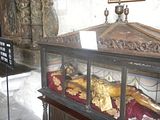
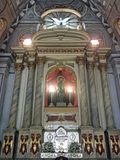
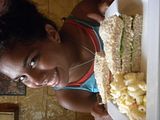
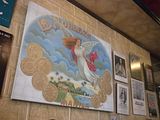
The Light Show was basically a walking tour which had wax figure robots, along with videos, light and sound. It illustrated the history of the Philippines from the pre-colonial era to the execution of Rizal. Since the display focused heavily on the life of Rizal, I’ll do the same and discuss his life here. As a side note, a few of the other interesting things the museum were: the discovery of an ancient human burial jar (800 BCE) known as the Manunggul Jar in which mummified bodies (done by applying hematite to the skin) were stored. Next was an introduction to the groups (Malaysian, Muslims, etc.) that came to the Philippines forming the first immigrations and cultural mixing. The Ma-Yi Chinese trading community began in the 9th century and involved trading Filipino gold and pearls for Chinese porcelain and silk. Finally, Lapu-Lapu (the native Tagalog tribe chief I mentioned earlier) kills Magellan and defeats his crew.


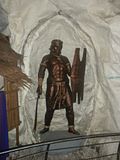

Finally we reach the colonialism era and conversion to Christianity with Legaspi’s arrival. The Spanish defeat local Rajah Suliman and start their reign over the Filipino people. Over the 3 centuries Spain was in the Philippines, its people were used as slaves in their own country. The city of Intramuros was built by Filipino slave labor for rich Spanish colonizers. The friars ran the place and used theocratic rule to submit the people. Many of the people were converted despite their treatment as lower class citizens as they realized conversion and intermarriage meant climbing the social ladder the Spanish had constructed in the Philippines. The hierarchy went as follows: native Filipinos at the bottom rank, then mixed Filipino/Chinese/etc.-Spanish officials, even higher were Spaniards born in the Philippines and at the top were the full-blood Spanish who were born in Spain.

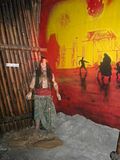
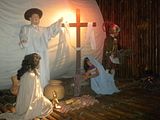
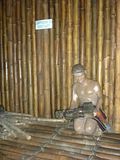

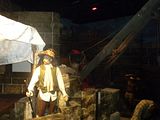
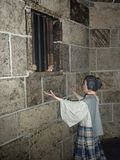
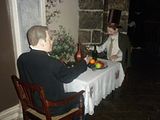
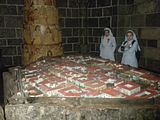
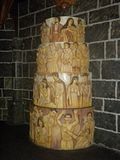
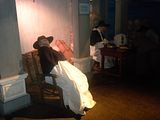
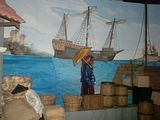

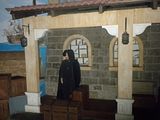
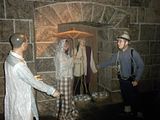
After a few displays showing how Filipinos kept their spirits positive through song and prayer, we came into a very large room showing a battle between the Filipinos and the Spaniards. There have been records of constant effort to rebel against the Spanish since they arrived by Filipinos – but each effort was put down. Until the birth of Jose P. Rizal! Rizal was born in 1861 and was a smart boy, learning to write poems by age 8. Rizal traveled to Europe, saw how the world lived, and realized his people were under great repression.
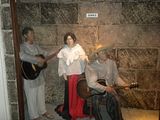
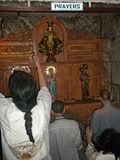
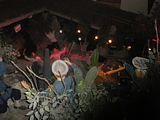
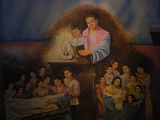
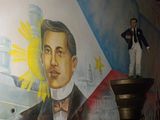
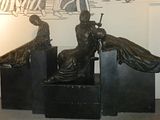
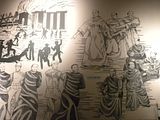
He decided to fight back! His weapon was his mind, and he published two books (Noli Me Tangere in 1887 and El Filibusterismo in 1891) which challenged Spanish theocratic rule. Various characters from Rizal’s books were portrayed and explained on the walls… we’ll have to read those books to really understand though, I’m sure! Rizal was arrested and exiled and his books were banned and burned. While in exile he worked as a doctor and refused attempts to ‘escape away’ offered to him by some. Simultaneously rebellions were growing more coordinated against the Spanish, increasing in stretch with secret organizations aiding. Eventually Rizal convicted of inciting rebellion, held in Fort Santiago, and sentenced to death. The Filipinos hold Rizal as their national hero.
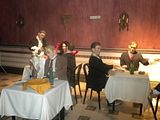
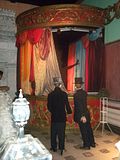
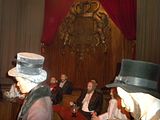
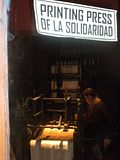
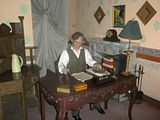
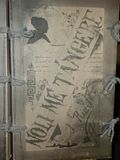
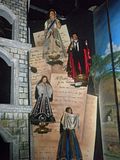

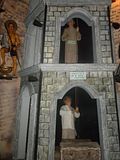
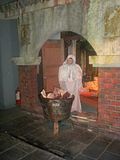
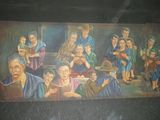
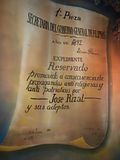
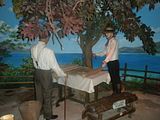
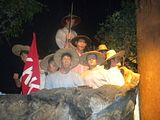
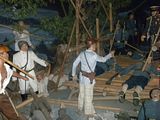
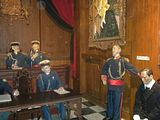
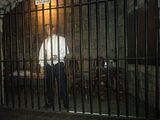

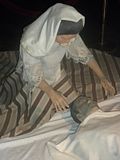
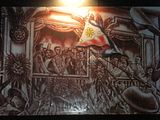
After the Light and Sound Museum, Henk and I took our trike again to the Bahay Tsinoy Museum where our driver dropped us off and we bid him farewell for the day. This museum was on the Chinese in Philippine Life “from sojourners to Tsinoys.” A Tsinoy is a “Chinese who is Filipino or a Filipino who is Chinese.” We walked through the exhibits quite exhausted already from our day, taking in the information from the wax figures and listings on the walls. Again we learned about the pre-colonial evidence of advanced trade between the Chinese and Filipinos. Then we learned about the shift in trade relationships once the Spanish arrived. The relationship between the Spaniards and the Chinese was from the start extremely tense. They burned down each other’s living areas (Intramuros for the Spaniards, the Parian for the Chinese) 8 times each!
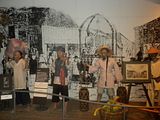
The brochure we picked up reads:
“When the Spaniards settled in the islands, more Chinese came [from previous 150 to 20,000] and served as the backbone of the Spanish colonial economy.[Filipinos served as agriculture/farming] Because of their growing numbers, the Spaniards both needed and feared them, which led to the persecution and harassments including large-scale massacres. The Chinese, or Sangley as the Spaniards called them, were separated into quarters called the Parian where they lived, worked, and made better lives for themselves as laborers, merchants, and artisans... Many Chinese in the Philippines also practiced religious syncretism, the unique product of Catholic and Buddhist intermarriage. Lorenzo Ruiz, the first Filipino saint, was born in Binondo to a Chinese father and a Filipino mother. ”
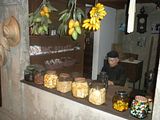
These intermarriages resulted in mixed religious worship that is quite interesting. The Chinese custom of burning incense in front of an alter of Kuan Yin or Mat-Su (both Buddhist feminine deities) became replaced with burning incense in front of the Virgin Mary’s image. Chinese fireworks and other celebratory Chinese features were used in Catholic processions and the Virgin was seen as a possible reincarnation of the former Buddhist deities. Intermarriages and baptism of Chinese men was encouraged by the Catholic friars trying to spread their domination and control the economy necessity.
We went upstairs where the museum had an example 1800’s mestizo house, along with photos and stories about national Filipino leaders of Chinese descent. The intermarriages between Filipinos and Chinese eventually led to an alliance against their shared oppression under the Spanish. It was the mixed-children of these marriages, the mestizos, who started revolting against Spanish rule after learning ideas of freedom through their studies of enlightened thought in University. Comprising only 5% of the population, they still created quite a stir. The historical timeline went on… and the alliance continued: there were photographs of the Chinese guerilla units fighting with Filipinos against the Japanese invaders during WWII! These modern images left quite an impression, and we left feeling like we understood the Filipino ‘mix’ culture a little bit more.

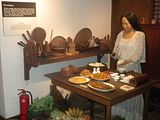
After a quick stop in the Roman Catholic Cathedral of Manila, we got in a cab and went to Makati, the fancy ‘Wall Street’ business area of Manila. Here is where we’d check out the Ayala Museum and pay a visit to the Hard Rock Café. (Another pin, Uncle Randy, is on the way!) The Ayala Museum was MUCH bigger than initially thought it would be. We arrived sometime after 4:00 PM and needed the entire 2 hours left of the opening time just to see the top two floors! (We were told to start from the top and work our way down.) Thus we’ll be going back another day to check-out the 2nd and Ground floors.
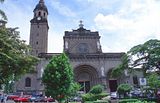

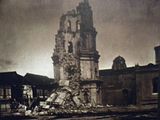
Anyways, the 4th floor was a special exhibit on gold, embroidery, and ceramics in the Philippines called, ‘Crossroads of Civilizations.’ The most interesting section of the 3-part exhibit was ‘Gold of Ancestors’ which began with a 10 minute movie on the history of the gold. The movie explained that gold has always been quite common in the Philippines, and ancient Filipino people (Tagalogs, Cagayanes, and Bisayas) wore much gold in their dress. Gold necklaces, earrings, bracelets, sashes, images of deities-- so much gold! There were even gold funeral masks that were placed on bodies during burial to ensure the body was not inhabited by evil spirits via the nose or mouth. (All orifices were covered by the mask.) But the most spectacular piece in my opinion was a decorative gold weapon-holster… which was an impressive thick chain of braided gold to be wrapped like a sash around the body and shoulder. Some of the groups also had extensive tattooing on their bodies. The following are images of ancient Filipino people from the Boxer Codex, a report the Spanish explorers made for their people back home.

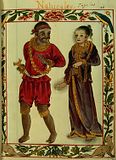
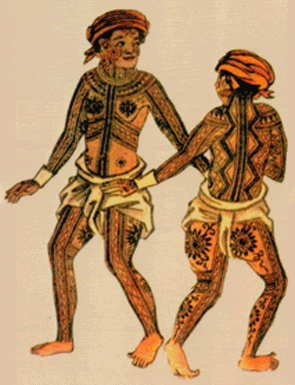
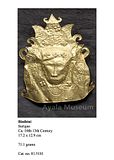
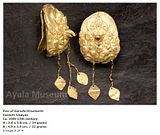

The 3rd floor Henk and I went through pretty quickly, hoping to have time to complete the 2nd floor and Ground floor as well. It was a gallery of paintings by 18th to 20th century Filipino artists. A few of the paintings were semi-interesting; I have to say I was kinda bored by most of them (one was a giant black feathery-looking splash on an otherwise all-white background… I mean, really?) -- But we again weren’t allowed to take photos so I have none for you here. Once we got to the 2nd floor however, we realized that we’d need at least 2 hours to listen to the full audio guide for the diorama exhibit I’d been looking forward to. Rather than rush it in 30 minutes, we decided to return again later, and went back to the 4th floor to explore the gold more.
After the museum we went through the mall outside of the museum to get to the Hard Rock Café. We arrived and decided to put our pin-buying on hold since they didn’t have the pin we wanted. Hopefully they will by the time we return to Manila! The long day behind us we went to Robinson’s Mall for dinner at the Pancake House again where I had a re-cap of ‘chicken-and-waffles’ and Henk tried a new shrimp salad. But don’t feel too bad for him eating just a salad; he got some of my waffles! We had to rest up because the next morning was out flight to Legaspi… WHALE SHARK TIME!!!
Talk to you all again soon!
Francesca

We then sat at Robinson’s enjoying a sample of purple ice-cream called “Ube,” a sweet and popular Filipino ice-cream that is made from yams. It took a while for the fan display to be set-up, so we walked around the mall. Henk and I ended up going back to the hostel, and he later went back to the mall to get his hair cut and take some pictures of the display for me. (This ended up being unnecessary since it was still up the next day!) The display was of Filipino paypay, which are hand-held fans used to keep cool. The display: “Crafted from various palm leaves, abaca, grasses including bamboo and vetiver (moras), even vines… the introduction of dyes… [made the fans] eye-catching… [and helped] signify their origin. ” Not just the color, but the shape of the fan marked the fan’s origin as well. Round fans were from Baler, flag-like fans from Vigan, ‘braided’ circle fans came from Bicol. The most popular fan is the heart-shaped, however. Take a look! (Also below is the Wiki picture of cake made from Ube. PURPLE!)





That night we ate at a cultural ‘dinner-and-a-show’ restaurant near the hostel called Zamboanga. While we dined on grilled chicken, French fries, fruit salad, and later a chocolate lava cake, we watched the show which ranged from ‘native’ pre-colonial dances, dances popularized in the Philippines by the Spanish, and a Japanese man being totally embarrassed by being forced on-stage in a grass skirt in front of his colleagues. Here are a few pictures of the various dances we saw:












The next day Henk and I set out early to actually get some touristy-things done. We planned originally to head to the bigger museums in Manila, such as the National Museum of the Filipino People. Alas, it was closed, along with the sister museum next to it. I checked the website! But even the hours listed at the museum gate were different, so I guess you just have to wing it in these places. We instead made our way to Rizal Park. After snapping a picture of the Rizal statue, we passed by his execution site (also closed) to another statue, this one a Revolutionary memorial. There was even a giant statue of Lapu-Lapu, a chieftain from Mactan in Cebu who, with 1000 followers, defeated Magellan’s forces and killed the man himself in 1521, delaying the Spanish’s colonization of the Philippines by some years. At the end of the park was a large map of the Philippines… but we weren’t so impressed.





Next we headed back to Intramuros for a walk through Casa Manila in the Plaza San Luis. Casa Manila is a replica house used as a “colonial lifestyle museum.” The brochure explains that, “its façade was copied from a house (1850s) at Calle Jaboneros in San Nicolas, a district across the river. In that area, the first floor of houses were rented out to shopkeepers… the uppermost floors [also] extend outwards, helping to shade pedestrians during the day [but] also aided in stabilizing the living quarters. Its construction (upper floor made of wood, lower floor of adobe volcanic stones) was an example of a safe earthquake-proof construction knowledge gained by Spanish families living in the area. We stood outside on the little granite-paved area called the “zaguan” or the corridor. This is where the carriages entered, dropping off their passengers before proceeding to park the horses. It was connected to the patio area with fountain, where we stood with Carlos the day before. The granite stones used in houses such as this originally came from Chinese junk ships but later were sold for patios in the 1800’s. We bought our tickets and entered the house. Sadly we weren’t allowed to take any pictures, so I’ll have to use the aid of our brochure and the included stock photos on their website to help you all visualize what we saw.

First we entered the “entresuelo” or the floor “between floors.” The brochure says, “…this area is where clients, tenants, or estate managers (if the owner was a rich landowner) wait before being admitted to the oficina (office).” We immediately noticed the beautiful detail in the wooden carvings on the ceiling and corners of the house. Very impressive. The furniture was carved wood and Mother of Pearl and everything looked expensive.

The “despacho” or “oficina” was, “where the owner of the house conducted business together with his clerks or accountants… the lubi-lubi plant (indigenious) [is] carved on the legs of the partners’ desk.” We continued walking through the house marveling as we went on just how large it was. It seemed to keep going and going! We later found out that this is because some extended family members (aunt, uncle, grandparents) lived with the nuclear family in the household.


One of the most impressive rooms was the large ‘antesala/caida’ which was for general hanging-out by family members or close friends. The more formal living room, the ‘sala’ was a even larger room which could be cleared out for balls and performances. The house even had a mini chapel room called the ‘oratorio’ with statues/dolls of saints and other religious images of worship called ‘santos.’ The master bedroom, which was offered to important guests who need to stay overnight, and held many pieces of furniture indicating the family’s wealth.


In the dining room we saw a working ‘punkah,’ which (according to the fan display from the mall) was: “a large, broad rectangular “fan” suspended from the ceiling. Hand-powered, one pulled on a rope to swing it to and fro. One of the guards demonstrated for us by pulling said rope. The kitchen was open to the dining room, so it must have gotten pretty hot in there. We looked around the kitchen which had fake food on display and examples of pantry-like storage. It even had a stovetop made of ash and water.


Beyond the kitchen was the toilet and washroom. The washroom was smartly placed near the kitchen, I’m guessing so hot baths would be easier. But the toilet was the real interesting area. There were two toilets side-by-side in the little room and there, according to the description on the wall, would be a checkerboard or other game board in between them. You could sit on the john with a friend and pass the time by challenging her/him to a game!
We then headed back to San Agustin’s Church for a second time. This time around we went upstairs, having a bit more time to wander around and get a few more photos. Next we went back outside, passing a memorial for those lost in the bombings of WWII. Henk and I had wanted to go to the ‘Light and Sound’ museum, which had a robotic historical display/show with wax figures but when we entered we were told we would have to pay for 10 tickets ($20 total) or wait for 8 more people to show up. Bummer! Luckily the cashier told us if we came back at 1:00 PM we would be able to join a group and see the show. Since we had about an hour to kill (and our next museum on the Chinese in Manila wasn’t open yet) we asked our trike driver to take us to Ilustrado (named after the ‘enlightened class’ of the Philippines who advocated racial equality and was anti-theocratic rule ) for lunch. While it was a little pricey, the décor was interesting and their water had a great aftertaste, almost tasted like cashews! We called the waiter over to find out what was in the water and he told us they put xxxxxxxxx leafs in it. Our lunch was simple but satisfying – chicken salad sandwich for myself (along with French fries) and chicken and corn soup for Henk. Next it was back on the trike and back to the Light and Sound Museum!




The Light Show was basically a walking tour which had wax figure robots, along with videos, light and sound. It illustrated the history of the Philippines from the pre-colonial era to the execution of Rizal. Since the display focused heavily on the life of Rizal, I’ll do the same and discuss his life here. As a side note, a few of the other interesting things the museum were: the discovery of an ancient human burial jar (800 BCE) known as the Manunggul Jar in which mummified bodies (done by applying hematite to the skin) were stored. Next was an introduction to the groups (Malaysian, Muslims, etc.) that came to the Philippines forming the first immigrations and cultural mixing. The Ma-Yi Chinese trading community began in the 9th century and involved trading Filipino gold and pearls for Chinese porcelain and silk. Finally, Lapu-Lapu (the native Tagalog tribe chief I mentioned earlier) kills Magellan and defeats his crew.




Finally we reach the colonialism era and conversion to Christianity with Legaspi’s arrival. The Spanish defeat local Rajah Suliman and start their reign over the Filipino people. Over the 3 centuries Spain was in the Philippines, its people were used as slaves in their own country. The city of Intramuros was built by Filipino slave labor for rich Spanish colonizers. The friars ran the place and used theocratic rule to submit the people. Many of the people were converted despite their treatment as lower class citizens as they realized conversion and intermarriage meant climbing the social ladder the Spanish had constructed in the Philippines. The hierarchy went as follows: native Filipinos at the bottom rank, then mixed Filipino/Chinese/etc.-Spanish officials, even higher were Spaniards born in the Philippines and at the top were the full-blood Spanish who were born in Spain.















After a few displays showing how Filipinos kept their spirits positive through song and prayer, we came into a very large room showing a battle between the Filipinos and the Spaniards. There have been records of constant effort to rebel against the Spanish since they arrived by Filipinos – but each effort was put down. Until the birth of Jose P. Rizal! Rizal was born in 1861 and was a smart boy, learning to write poems by age 8. Rizal traveled to Europe, saw how the world lived, and realized his people were under great repression.







He decided to fight back! His weapon was his mind, and he published two books (Noli Me Tangere in 1887 and El Filibusterismo in 1891) which challenged Spanish theocratic rule. Various characters from Rizal’s books were portrayed and explained on the walls… we’ll have to read those books to really understand though, I’m sure! Rizal was arrested and exiled and his books were banned and burned. While in exile he worked as a doctor and refused attempts to ‘escape away’ offered to him by some. Simultaneously rebellions were growing more coordinated against the Spanish, increasing in stretch with secret organizations aiding. Eventually Rizal convicted of inciting rebellion, held in Fort Santiago, and sentenced to death. The Filipinos hold Rizal as their national hero.




















After the Light and Sound Museum, Henk and I took our trike again to the Bahay Tsinoy Museum where our driver dropped us off and we bid him farewell for the day. This museum was on the Chinese in Philippine Life “from sojourners to Tsinoys.” A Tsinoy is a “Chinese who is Filipino or a Filipino who is Chinese.” We walked through the exhibits quite exhausted already from our day, taking in the information from the wax figures and listings on the walls. Again we learned about the pre-colonial evidence of advanced trade between the Chinese and Filipinos. Then we learned about the shift in trade relationships once the Spanish arrived. The relationship between the Spaniards and the Chinese was from the start extremely tense. They burned down each other’s living areas (Intramuros for the Spaniards, the Parian for the Chinese) 8 times each!

The brochure we picked up reads:
“When the Spaniards settled in the islands, more Chinese came [from previous 150 to 20,000] and served as the backbone of the Spanish colonial economy.[Filipinos served as agriculture/farming] Because of their growing numbers, the Spaniards both needed and feared them, which led to the persecution and harassments including large-scale massacres. The Chinese, or Sangley as the Spaniards called them, were separated into quarters called the Parian where they lived, worked, and made better lives for themselves as laborers, merchants, and artisans... Many Chinese in the Philippines also practiced religious syncretism, the unique product of Catholic and Buddhist intermarriage. Lorenzo Ruiz, the first Filipino saint, was born in Binondo to a Chinese father and a Filipino mother. ”

These intermarriages resulted in mixed religious worship that is quite interesting. The Chinese custom of burning incense in front of an alter of Kuan Yin or Mat-Su (both Buddhist feminine deities) became replaced with burning incense in front of the Virgin Mary’s image. Chinese fireworks and other celebratory Chinese features were used in Catholic processions and the Virgin was seen as a possible reincarnation of the former Buddhist deities. Intermarriages and baptism of Chinese men was encouraged by the Catholic friars trying to spread their domination and control the economy necessity.
We went upstairs where the museum had an example 1800’s mestizo house, along with photos and stories about national Filipino leaders of Chinese descent. The intermarriages between Filipinos and Chinese eventually led to an alliance against their shared oppression under the Spanish. It was the mixed-children of these marriages, the mestizos, who started revolting against Spanish rule after learning ideas of freedom through their studies of enlightened thought in University. Comprising only 5% of the population, they still created quite a stir. The historical timeline went on… and the alliance continued: there were photographs of the Chinese guerilla units fighting with Filipinos against the Japanese invaders during WWII! These modern images left quite an impression, and we left feeling like we understood the Filipino ‘mix’ culture a little bit more.


After a quick stop in the Roman Catholic Cathedral of Manila, we got in a cab and went to Makati, the fancy ‘Wall Street’ business area of Manila. Here is where we’d check out the Ayala Museum and pay a visit to the Hard Rock Café. (Another pin, Uncle Randy, is on the way!) The Ayala Museum was MUCH bigger than initially thought it would be. We arrived sometime after 4:00 PM and needed the entire 2 hours left of the opening time just to see the top two floors! (We were told to start from the top and work our way down.) Thus we’ll be going back another day to check-out the 2nd and Ground floors.



Anyways, the 4th floor was a special exhibit on gold, embroidery, and ceramics in the Philippines called, ‘Crossroads of Civilizations.’ The most interesting section of the 3-part exhibit was ‘Gold of Ancestors’ which began with a 10 minute movie on the history of the gold. The movie explained that gold has always been quite common in the Philippines, and ancient Filipino people (Tagalogs, Cagayanes, and Bisayas) wore much gold in their dress. Gold necklaces, earrings, bracelets, sashes, images of deities-- so much gold! There were even gold funeral masks that were placed on bodies during burial to ensure the body was not inhabited by evil spirits via the nose or mouth. (All orifices were covered by the mask.) But the most spectacular piece in my opinion was a decorative gold weapon-holster… which was an impressive thick chain of braided gold to be wrapped like a sash around the body and shoulder. Some of the groups also had extensive tattooing on their bodies. The following are images of ancient Filipino people from the Boxer Codex, a report the Spanish explorers made for their people back home.






The 3rd floor Henk and I went through pretty quickly, hoping to have time to complete the 2nd floor and Ground floor as well. It was a gallery of paintings by 18th to 20th century Filipino artists. A few of the paintings were semi-interesting; I have to say I was kinda bored by most of them (one was a giant black feathery-looking splash on an otherwise all-white background… I mean, really?) -- But we again weren’t allowed to take photos so I have none for you here. Once we got to the 2nd floor however, we realized that we’d need at least 2 hours to listen to the full audio guide for the diorama exhibit I’d been looking forward to. Rather than rush it in 30 minutes, we decided to return again later, and went back to the 4th floor to explore the gold more.
After the museum we went through the mall outside of the museum to get to the Hard Rock Café. We arrived and decided to put our pin-buying on hold since they didn’t have the pin we wanted. Hopefully they will by the time we return to Manila! The long day behind us we went to Robinson’s Mall for dinner at the Pancake House again where I had a re-cap of ‘chicken-and-waffles’ and Henk tried a new shrimp salad. But don’t feel too bad for him eating just a salad; he got some of my waffles! We had to rest up because the next morning was out flight to Legaspi… WHALE SHARK TIME!!!
Talk to you all again soon!
Francesca

2 Comments:
Hallo Lieverds
Alvast bedankt voor de verhalen,ik heb ze nog niet gelezen,maar ik bewaar ze voor zondag.
Liefs Omaxxx
Hallo Francesca,
Dank je wel voor je verhaal, dat was weer een snuifje cultuur en historie waar je u tegen zegt.
En heb je nu voor het eerst paars ijs gegeten??
Ik ga nu Henk-Jan zijn verhaal lezen en ben nieuwsgierig naar zijn nieuwe haar-cut!!
Dikke kus
Gina
Post a Comment
<< Home